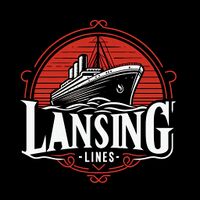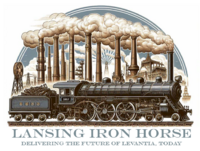Lansing Lines: Difference between revisions
Tag: 2017 source edit |
mNo edit summary Tag: 2017 source edit |
||
| Line 1: | Line 1: | ||
{{Infobox company | {{Infobox company | ||
| name = | | name = | ||
| logo = | | logo = Lansing_Lines_logo.jpg | ||
| logo_size = | | logo_size = 200 | ||
| logo_alt = | | logo_alt = | ||
| logo_caption = | | logo_caption = Logo of Lansing Lines | ||
| type = {{wp|Public company|Public}}-stateowned | | type = {{wp|Public company|Public}}-stateowned | ||
| traded_as = LLC | | traded_as = LLC | ||
Revision as of 16:35, 6 January 2024
 Logo of Lansing Lines | |
| Public-stateowned | |
| Traded as | LLC |
| Industry |
|
| Founded | 1485 |
| Founder | Hummelman Lansing |
| Headquarters |
|
Area served | Worldwide |
Key people | CEO: Emery-Julian duQuesne leCocque |
Founded in 1458, Willing, in what is now Yonderre by a Gothic peasant who has joined the retinue of Joanus de Martigueux, Hummelman Lansing, the workshop was initially focused on chandelling. Hermann's nephew, Emille leLansing, consolidated the operations upon Hummelman's death in 1485, bringing the atelier into his larger riverine boatyard in Collinebourg. The consolidation worked and the chantier was soon able to get a contract to build ships for the Dukes of Yonderre. Being one of the first multi-service chantiers in the city, they did well. Their entire operation was burned down in the Great Fire of Collinebourg in 1728. Having lost everything, Henri-Eugene deMeur, the owner at the time, moved to Granblaix, in the Principality of Faramount and started a new chantier there. There was stiff competition, so he needed to find a way to stant out
In 1730, the new chantier were contracted by the Marialanii Ularien Trading Company to build a massive ship, the largest ever built in Maritime Dericania, to bring material to the Barbary Straits colony and return with cargoes. They built the Vent du Nord, a 69 m (226 ft) ship, with 1,275 square m (13,720 sq ft) of sail yardage, that was equipped both for trade and for fighting off Kiravian merchantmen and Barbary pirates. The ship had 35 guns and was capable of carrying 200 tonnes of cargo. After two years of rushed construction, the Vent du Nord was launched in May, 1733, but the ship was observed to be top heavy. On her maiden voyage, under the watchful gaze of much of the cityfolk and even the Duke of Marialianus, a strong gust of wind caught the full yardage of the sails and heeled the top-heavy ship and the lowest gun ports started to fill with water. The ship righted and sailed on, but there was a definite list to port. Tacking, the ship caught another gust and heeled again. This time, with the water ballast in the hull as well as the new water coming in the lower gun ports, the ship started to rapidly fill with water and sink. To the astonishment and dismay of the crowd, the ship slowly disappeared into the water, until 3/4 submerged it came to rest on the seabed. The reputation of the chantier was in tatters and the masts of the ship sticking out of the harbor waters were a daily reminder of what had become known as Vent du Nord syndrome. The owner, Henri-Eugene deMeur, took the loss too hard and committed suicide by throwing himself into the bay. The company disvolved and its land and equipment were sold off to other chantiers and ateliers.
In 1754, Laurent-Girart Vaugeois deLansing, Vicomte of Teal, 5th great-grandson of Hummelman Lansing, purchased a series of ships and salvage rights with a plan to raise the Vent du Nord as the harbor had expanded and the submerged ship was impeding the newly increased traffic. He proposed a rig of two ships in tandem that would float over the Vent du Nord, a rope encircling the hull and a series of pullies that would be used to hoist the ship up from the seabed. In order to lighten the ship, the masts would have to be removed, the canons too. The Vicomte, devised a diving bell to allow workers to be able to work on small projects. He also devised long saws to reach down under the bell to get at the masts. After 3 years of working on the plans and some trial and error the salvage mission began. It was a rocky start but after 5 years the hull was actually raised, drug out to sea and resunk 12nm off of the harbor. The Vicomte was lauded as have redeemed the Lansing family name and started a salvage operation that spanned the ports and cities of the Kilikas Sea.
In 1794, the Lansing Salvage Company bought a fledgling shipping firm and secured the monopoly on importing clover and timber from Ilánova, Kiravia. The shipping route was immediately profitable, and the fleet tripled in size over the next 20 years, to 9 ships. Throughout the 19th century, the Lansing company secured various shipbuilding and salvaging contracts with the various Maritime Dericanian companies and foreign powers. Starting in the 1910s, Lansing started to invest heavily in rail infrastructure, deciding that instead of competing with O’Shea Container Shipping, they would benefit from the land-based logistics business that O'Shea was creating. In 1917 they created a subsidiary that would eventually become Lansing Iron Horse.
Divisions
Shipyard
Military Service Ships
| Model Name | Specifications | Image | Type |
|---|---|---|---|
| Lauder Class |
|
Sea Lift Ship | |
| Maria Class |
|
Hospital Ship | |
| Troller Class |
|

|
N/A |
| Jaxson Class |
|
Beachhead Aerial Support Ship | |
| Global Strike Class |
|
Theater Logistics Ship | |
| Bridger Class |
|

|
High Speed
Logistics Ship |
| Kilikas Stormer Class |
|
Icebreaker | |
| Pelican Class |
|

|
ELINT |
|
|

|
Corvette/Aviso |
Lansing Iron Horse

In 1967, Armand-Ere Locomotion and Lansing Iron Horse formed a joint venture partnership as part of the economic reforms of the Levantine Union.